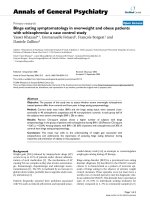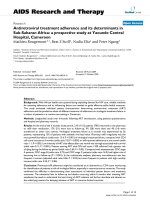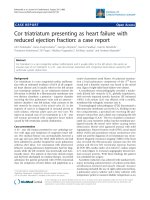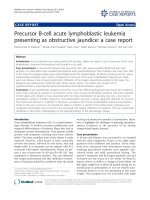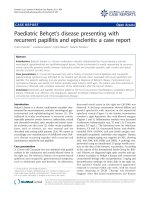Báo cáo y học: "TCMGIS-II based prediction of medicinal plant distribution for conservation planning: a case study of Rheum tanguticum" ppt
Bạn đang xem bản rút gọn của tài liệu. Xem và tải ngay bản đầy đủ của tài liệu tại đây (5.55 MB, 9 trang )
RESEARC H Open Access
TCMGIS-II based prediction of medicinal plant
distribution for conservation planning:
a case study of Rheum tanguticum
Hua Yu
1†
, Caixiang Xie
1†
, Jingyuan Song
1
, Yingqun Zhou
1,3
, Shilin Chen
1,2*
Abstract
Background: Many medicinal plants are increasingly endangered due to overexploitation and habitat destruction.
To provide reliable references for conservation planning and regional management, this study focuses on large-
scale distribution prediction of Rheum tanguticum Maxim. ex Balf (Dahuan g).
Methods: Native habitats were determined by specimen examination. An improved version of GIS-based program
for the distribution prediction of traditional Chinese medicine (TCMGIS-II) was employed to integrate national
geographic, climate and soil type databases of China. Grid-based distance analysis of climate factors was based on
the Mikowski distance and the analysis of soil types was based on grade division. The database of resource survey
was employed to assess the reliability of prediction result.
Results: A total of 660 counties of 17 provinces in China, covering a land area of 3.63 × 10
6
km
2
, shared similar
ecological factors with those of native habitats appropriate for R. tanguticum growth.
Conclusion: TCMGIS-II modeling found the potential habitats of target medicinal plants for their conservation
planning. This technology is useful in conservation planning and regional management of medicinal plant
resources.
Background
More than one-tenth of plant species are used in drugs
and health products [1]. The demand for herbal drugs
and health products is steadily growing [2]. Thus, many
medicinal herbs are threatened by overexploitation,
habitat destruction and lack of proper cultivation prac-
tices. Some wild species are disappearing at alarming
rates [3,4] . Rheum tanguticum Maxim. ex Balf
(Dahua ng) is one of those species. R. tanguticum
belongs to the family Polygonaceae and is a high-alti-
tude perennial herb sensitive to high temperature,
mainly found in the alpine regions of temperate and
subtropical Asia, espec ially in Southwest and Northwest
China (e.g. Sichuan , Gansu and Qinghai) [5,6]. As a
source for rhubarb according to the Chinese Pharmaco-
poeia and a purgative and anti-inflammatory agent [7],
R. tanguticum has been overexploited, suffering from
replant diseases, inadequate seed dispersal, low repro-
ductive efficiency and narrow distribution and habitat
fragmentation, l eading to its declines in the wild
resources [6,8].
In-situ conservation, which considered as the method
of conserving endangered species in their wild habitats,
is promising in protecting indigenous species and main-
taining natural communities along with their intricate
network of relat ionships [9]. As habitat degradation and
destruction is increasing, ex-situ conservation regarded
as the process of cultivating and naturalizing endangered
species outside of their original habitats, has become a
practical alternative [10-12], especially for those over-
exploited and endangered medicinal plants with slow
growth, small abundance and replant diseases [10,13],
e.g. Paris species in family Trilliaceae and Panax species
in family A raliaceae [14]. Ex-situ cultivation becomes an
immediate action to sustain medicinal plant resources
[11,12].
* Correspondence:
† Contributed equally
1
Institute of Medicinal Plant Development, Chinese Academy of Medical
Sciences, Peking Union Medical College, Beijing 100193, China
Full list of author information is available at the end of the article
Yu et al. Chinese Medicine 2010, 5:31
/>© 2010 Yu et al; licensee BioMed Central Lt d. This is an Open Access article distributed under the te rms of the Creative Commons
Attribu tion License ( which permits unrestricted use, distribution, and reproduction in
any medium, provided the original work is properly cited.
Understanding the geographical distribution of plant
speciesisessentialfortheirex-situ conservation activ-
ities [1,15]. Although many plant species can be success-
fully introduced, cultivated and naturalized in a wide
range of habitats across countries and contine nts [16],
their growth and distribution in different habitats are
based on local indicators [17], e.g. soil properties, cli-
mate conditions and environmental features [18]. Agui-
lar-Stoen and Moe (2007) found that many medicinal
plants thriving in harsh habitats and disturbed areas are
of high medicinal efficacy because rocky and dry habi-
tats stimulate their secondary metabolites [19]. Many
plants are only found in places where the habitat is con-
gruent with their growth [18], e.g. the propagation and
quality of Banksia serrata varied among habitats [20].
Variations in growth and metabolites of medicinal plants
among niches make ex-situ conservation habitat-specific.
Geographical prediction of plant distribution is impor-
tant to resource c onservation planning and regional
management decisions [21]. Geographic Information
System (GIS) is useful in predicting the spatia l distribu-
tion of target species [22]. GIS assesses multiple interde-
pendent abiotic factors, e.g. solar radiation, air
temperature, precipitation and soil properties [23],
affecting plant distribution, models the environmental
niches of target plants [24] and refines their distribution
maps for conservation planning [25].
A GIS-based computer program (TCMGIS-I) was
developed specially for the distribution prediction of Chi-
nese medicine (CM) [2 5,26]. Integrating national geo-
graphic, climate and soil type databases of China,
TCMGIS-I was able to determine the impacts of environ-
mental gradients and predict the lar ge-scale distrib utio n
of target medicinal plants [26]. Tests with some common
medicinal plants (e.g. Panax ginseng, Pa nax quinquefo-
lium, Glycyrrhiza uralensis and Artemisia annua)
demonstrated that TCMGIS-I prediction was consistent
with the actual plants’ distribution patterns [27-30].
While TCMGIS-I captures da ta from literature,
TCMGIS-II can perform more precise variable extrac-
tion from the native habitats of target medicinal plants.
Factors such as elevation, air temperature, solar radia-
tion, precipitation and soil properties are considered by
TCMGIS-II. Moreover, TCMGIS-II defines the native
habitats of a target plant through spec imen examination
and extracts the target variables of native habitats from
its databases.
The present study aims to determine (1) the most
important ecological factor(s) on the distribution of
R. tanguticum, (2) whether the prediction results are
consistent with survey data and (3) the implications of
the prediction results for the conservation planning of
R. tanguticum .
Methods
Database descriptions
Based on a spatially referenced GIS model, TCMGIS-II
integrated four databases, including the national geo-
graphic, climate and soil type databases of China which
were used to generate distribut ion models and the data-
base of resource survey which was used to assess the
quality of a model.
The geographic database of China was a digital chart
(scale 1:1,000,000) at na tional, provincial, re gional and
county levels, including a series of vector maps of layers,
i.e. manuals on roads, contours, geology and administra-
tive boundaries, with all points covered with a geographic
coordinate system (e.g. latitude, longitude and elevation).
The climate database of China was derived from the
national climate data coving from the period of 1971 to
2000 extracted from the climate records of the state
meteorological administration of China. The database
included climate attributes related to plant growth, e.g.
sunshine duration, relative humidity, annual precipitation,
accumulated temperature, mean annual temperature,
mean March temperature, annual m aximum/minimum
temperature and annual mean maximum/minimum tem-
perature. The climate data were available in GIS along
with data of latitude, longitude and elevation.
The soil type database of Chi na covered a total of
2,444 counties, containing a series of vector soil maps
(scale 1:1,000,000) and soil attributes and mapping unit
boundaries. The soil data were classified into 12 orders,
29 suborders, 61 groups, 235 subgroups and 909 families
as the basic elements of the map layers [31].
Thedatabaseofresourcesurveywasgeneratedwith
the third national resource survey of CM in China, cov-
ering a total of 11,118 plant species in 2312 genera of
385 families, including 298 fungi, 114 algae, 43 mosses,
55 lichens, 455 ferns, 126 gymnosperms and 10,027
angiosperms [32], as well as descriptions on the abun-
dance and distribution patterns of 138 rare and endan-
gered medicinal plants, 126 of which were converted
into digital charts (scale 1:1,000,000).
Model descriptions
TCMGIS-II identified, analyzed and displayed geogra-
phically referenced information, using two major data
models (i.e. raster and vector). Raster model in 1.0 ×
1.0 km
2
grids detected the grids sharing similar ecologi-
cal factors with those of the native habita ts of a target
medicinal plant. Vector model stacked th e layers of those
factors to determine the distribution areas and ranges.
Extraction of ecological factors from native habitats
Based on 75 type specimens of wild R. tang uticum
from Chinese Virtual Herbarium, we set up 206 plots
Yu et al. Chinese Medicine 2010, 5:31
/>Page 2 of 9
in 26 towns of nine counties in the provinces of
Gansu, Qinghai and Sichuan (Figure 1), the native
habitats of R. tanguticum. The ecologica l factors of the
plots were extracted by TCMGIS-II, including eleva-
tion, soil type, sunshine duration, relative humidity,
annual precipitation, accumulated temperature,
mean annual temperature, mean March temperature,
annual maximum/minimum temperature and
annual mean maximum/minimum temperature (Table
1). The variables extracted from the native habitats
weresetastargetvariablesfor distance analysis with
grids.
Figure 1 Native habitats of Rheum tanguticum Maxim. ex Balf Blue plotsin 26 towns were set up for the extraction of target variables.
Table 1 Variables extracted from the native habitats of Rheum tanguticum Maxim. ex Balf based on TCMGIS-II
combined geographic, climate and soil type databases
Variable Unit Range Mean ± SE F-value C
v
(%)
Elevation m 1980, 4550 3630 ± 44 191.2*** 17.4
Relative humidity % 54.8, 69.0 63.7 ± 2.2 219.3*** 49.6
Sunshine duration hr/yr 1897, 2704 2450 ± 13 301.7*** 7.6
Annual precipitation mm 331, 839 574 ± 7 233.2*** 17.5
Accumulated temperature °C 3193, 22451 9517 ± 951 277.1*** 143.4
Mean annual temperature °C 5.1, 13.1 8.6 ± 0.1 92.6*** 16.7
Mean March temperature °C -8.0, -2.0 -4.5 ± 0.2 42.3*** 63.8
Minimum temperature °C -24.8, -10.6 -19.1 ± 0.2 165.8*** 15.0
Maximum temperature °C 12.9, 24.4 17.2 ± 0.2 119.5*** 16.7
Mean minimum temperature °C -15.6, -5.1 -11.2 ± 0.2 129.8*** 25.6
Mean maximum temperature °C 6.0, 18.2 10.4 ± 0.2 103.3*** 27.6
Soil type* pH 5.9, 8.5 6.8 ± 0.1 112.4*** 21.1
* Soil type was assigned according to soil grade division in TCMGIS-II program.
Values of pH were employed as an indicator of soil types for statistical analysis.
F-value indicates the difference in target variable extracted from different native habitats (*** P < 0.001, ** P <0.01,and*P < 0.05).
SE: standard error of means
C
v
: coefficient of variation
Yu et al. Chinese Medicine 2010, 5:31
/>Page 3 of 9
Data normalization and distance analysis
As there were variations in factors (e.g. climate factors
and soil type), TCMGIS-II normalized data by joining
the mean absolute deviation of each pair of factors. To
determine the similarity rate between grids and target
variables from native habitats, we conducted distance
measurement based on grid-based analysis. Distance
analysis of soil was conducted according to grade divi-
sion, while the distance analysis of elevation and climate
factors was conducted based on Mikowski distance [33],
in TCMGIS-II as follows:
dq x y
ij ij ij
q
i
n
q
()
/
=−
⎛
⎝
⎜
⎜
⎞
⎠
⎟
⎟
=
∑
1
1
Where x
ij
is the grid value and y
ij
is a target variable.
When q = 1, it is Manhattan distance.
When q = 2, it is Euclidean distance.
Long distance indicates low similarity rates while short
distance indicates high similarity rates.
Spatial distribution division and model quality
assessment
Division on spatial distribution of R. tanguticum was
established according to the grid-based clustering. The
areas sharing similar ecological factors with those of
native habitats were favorable for R. tanguticum distri-
bution. The spatially predicted areas were divided into
three types, namely the favorable (with similarity rate
≥95%), suitable (with similarity rate 90-95%), and slightly
appropriate (with similarity rate < 90%) for R. tanguti-
cum distribution.
To assess the reliability of the spatial prediction on
R. tanguticum distribution, we employed the database of
resource survey as a measure. The overlapping part
between distribution range predicted by TCMGIS-II and
that recorded by resource survey indicates the con-
gruency, the part with prediction result without survey
data suggests the potential distribution of R. tanguticum,
and the rest part with survey data beyond prediction
result indicates the contradiction between prediction
result and survey data.
Statistical analyses
To detect the variations in the abiotic factors (e.g. eleva-
tion, air temperature, solar radiation, precipitation and
soil properties in Table 1) of different native habitats,
we employed the coefficient of variation (C
v
) as a mea-
sure [34]. It is defined as the follows:
C
v
=×
100%
Where s is the standard deviation and μ is the mean.
We employed one-way analysis of variance (one-way
ANOVA) to analyze the differences in the abiotic factors
responding to different native habitats (Table 1), and
principal components analysis (PCA) to evaluate the
contributions of the abiotic factors to R. tanguticum dis-
tribution (Figure 2).
Figure 2 Plo t of component scores determined by principal component analysis on target va riables from the native habitats of
Rheum tanguticum Maxim. ex Balf PC indicates a principal component.
Yu et al. Chinese Medicine 2010, 5:31
/>Page 4 of 9
Results
Target variables extracted from native habitats
TCMGIS-II extracted the target variables from 206 plots
in the native habitats of R. tanguticum (Figure 1, Table
1). The results showed that the target variables varied
significantly among different native hab itats (Table 1, P
< 0.001), with coefficient of varia tion ranging from 7.6%
in sunshine duration to 143.4% in accumulated
temperature, and the native habitats exhibited high ele-
vation and abundant sunshine with moderate c ool and
dry climate in mild acid and basic soils (Table 1). Us ing
PCA, we extracte d two principal components (PCs)
which accounted for 93.8% of the contribu tion of target
variables in terms of R. tanguticum distribution (Fig ure
2). The PC
1
(PC
1
= 60.3%) was mainly related to tem-
peratures (e.g. annual maximum, annual mean
Figure 3 Spatial distribution of Rheum tanguticum Maxim. ex Balf predicted by TCMGIS-II. (a) Favorable area with similarity rate ≥95% and
(b) suitable area with similarity rate 90-95%. Longitude (°E) and latitude (°N) are given.
Yu et al. Chinese Medicine 2010, 5:31
/>Page 5 of 9
maximum, mean annual and acuminated temperatures)
and the PC
2
(PC
2
= 33.5%) w as mainly contributed by
annual precipitation and relative humidity. However,
elevation and annual precipitation were negatively corre-
lated to PC
1
, and sunshine duration was negatively con-
tributed to PC
2
(Figure 2).
Prediction result of potential distributions
The spatial distribution of R. tanguticum was established
by overlapping the layers of those geographic , climate
and soil factors based on distance analyses. The scope of
favorable areas (with similarity rate ≥95%) was within
80°26′-131°21′ E and 27°03′-45°21′N (Figure 3a), covering
395 counties in 13 provinces such as Xizang (Tibet),
Sichuan, Qinghai and Gansu in China with a land area
of 7.46 × 10
5
km
2
(Figure 4). The scope of suitable areas
(similarity rate 90-95%) was within 74°05′-132°24′ Eand
26°38′-47°22′N (Figure 3b), covering 396 counties i n 17
provinces with a land area of 2.89 × 10
6
km
2
(Figu re 4).
In addition to 131 counties of bot h favorable and suita-
ble ranges, 660 counties were tested suitable for R. tan-
guticum cultivation (similarity rate ≥90%).
Comparison between prediction results and survey data
Rhubarb distributed in 101 counties in Sichuan, Xizang
and Qinghai provinces within the range of 89°25′-107°
16′E and 27°05′-39°06′N (Figure 5). Comparison between
the distribution count ies predicted by TCMGIS-II mod-
eling and recorded by resource survey demonstrated the
high quality of prediction result (Figure 6). Specifically,
a total of 663 c ounties were listed by the survey data
and prediction result, with 97.0% of survey data covered
by the prediction result of TCMGIS-II analysis. The
majority (85.2%) of prediction data corresponded to no
survey data and 2.9% of s urvey data did not overlap
with the prediction results.
Discussion
The ecological factors from native habitats suggest that
R. tanguticum grows a t high plateau (e.g. alpine mea-
dow, grassland and shrub) with cool climate, abundant
sunshine, moderate precipitation and basic soils (e.g.
humus-r ich loam and sandy loam) and that its distribu-
tion is mainly influenced by temperature (e.g. annual
maximum , mean annual and acuminat ed temperatures),
annual precipitation and relative humidity. The predic-
tion results by TCMGIS-II confirmed the distribution
data.
Many plant species have evolved to be habitat-specific
and sensitive to environmental conditions [35], and
those growing at the sites congruent with their native
habitats are the most potent [17]. For example, R. tan-
guticum from Gansu and Qinghai is recor ded as a
source of rhubarb in the Chinese Pharmacopoeia due to
its high potency [7,32]. The present study found that a
large portion of predictive distributions were beyond
what survey data covered (e.g. Xinjiang, Inner-Mongolia
and Shanxi provinces), agreeing with the notion that
prediction of distribution may help locate habitats for
conservation [24,36], giving insights into the discovery
of potential habitats for R. tanguticum cultivation.
Interestingly, a small portion of survey data does not
overlap with prediction result, e.g. Muli in Sichuan and
Zhongdian in Yunnan. According to the Chinese Phar-
macopoeia, there are three prescribed sources (i.e. R.
tanguticum, R. palmatum and R. officinale) for rhubarb
[7]. The survey data cover the three Rheum species. On
the other hand, the databases of TCMGIS-II include
Figure 4 Detailed distribution of Rheum tanguticum Maxim. ex Balf predicted by TCMGIS-II in China. Favorable area with similarity rate
≥95% (dark) and the suitable area with similarity rate 90-95% (hatched).
Yu et al. Chinese Medicine 2010, 5:31
/>Page 6 of 9
many abiotic factors (e.g. topographic features, climate
conditions and soil properties) but not the effects of
dynamic biotic interactions and species-speci fic features
on a large scale. Many plant spec ies are sensitive to
both abiotic and biotic factors, such as competitor
plants and symbiotic species [37,38].
In the present study, the distribution of R. tanguticum
predicted by TCMGIS-II program was confirmed by the
resource survey data. We expect that the TCMGIS-II
modeling is useful in conservation planning and regional
management for the threatened medicinal plants [19].
Both conservation and sustainable utilization of medic-
inal plants require robust large-scale assessment of their
distribution and regionalization [1]. Lack of data and
limit of model validity are barriers for the studies on
distribution of medicinal plants on a large scale [39].
Thus, more data and model verification are necessary
for further studies and GIS developments.
Conclusion
TCMGIS-II program was confirmed to be useful in the
discovery of potential habitats congruent with the native
habitats of target medicinal plants. This techno logy pro-
vides reliable r eferences for the conservation planning
and regional man agement of endangered and threatened
medicinal plant resources.
Figure 6 Comparison between the distribution counties of Rheum tanguticum Maxim. ex Balfpredicted by TCMGIS-II and recorded by
the survey data. Latticed: the counties of survey data in prediction result. Left hatched: those of prediction results without survey data. Right
hatched: those of survey data beyond prediction results. The percentage and number of counties in each part are given.
Figure 5 Dis tribution map of rhubarb generated based on the database of resource survey. The red dots show that there existed the
wild resources of R. tanguticum in the counties. Longitude (°E) and latitude (°N) are given.
Yu et al. Chinese Medicine 2010, 5:31
/>Page 7 of 9
Abbreviations
CM: Chinese medicine; GIS: geographic information system; TCMGIS-I: a GIS-
based program for the distribution prediction of traditional Chinese
medicine; TCMGIS-II: the improved version of TCMGIS-I program; C
v
:
coefficient of variation; One-way ANOVA: one-way analysis of variance; PCA:
principal components analysis; PC: a principal component; SE: standard error.
Acknowledgements
We thank Prof Yulin Lin for his help with specimen identification, Prof
Chengzhong Sun and Prof Runhuai Zhao for their constructive comments
on TCMGIS-II modeling, Prof Christine Leon and Mr Chun Un for their
assistance in polishing the manuscript. This study was supported by the
National Key Technology R&D Programs in the 11
th
Five-year Plan of China
(2006BAI09B02, 2006BAI21B07) and China Post-doctoral Foundation
(20090450329).
Author details
1
Institute of Medicinal Plant Development, Chinese Academy of Medical
Sciences, Peking Union Medical College, Beijing 100193, China.
2
Hubei
University of Chinese Medicine, Wuhan 430065, China.
3
Technology
Development Centre, China National Group Corporation of Traditional and
Herbal Medicine, Beijing 100094, China.
Authors′ contributions
SC designed the study and revised the manuscript. HY examined the
specimens and wrote the manuscript. CX conducted the TCMGIS-II analysis,
JS and YZ helped specimen collection and statistical analysis. All authors
revised the manuscript. All authors read and approved the final version of
the manuscript.
Competing interests
The authors declare that they have no competing interests.
Received: 6 November 2009 Accepted: 25 August 2010
Published: 25 August 2010
References
1. Russell-Smith J, Karunaratne NS, Mahindapala R: Rapid inventory of wild
medicinal plant populations in Sri Lanka. Biol Conserv 2006, 132:22-32.
2. Hamilton AC: Medicinal plants, conservation and livelihoods. Biodivers
Conserv 2004, 13:1477-1517.
3. Mentreddy SR: Review - medicinal plant species with potential
antidiabetic properties. J Sci Food Agric 2007, 87:743-750.
4. Reddy KN, Reddy CS: First red list of medicinal plants of Andhra Pradesh,
India - conservation assessment and management planning. Ethnobot
Lealf 2008, 12:103-107.
5. Wu Z, Raven PH, Garden MB: Flora of China Beijing: Science Press 1994.
6. Wang XM, Ren Y: Rheum tanguticum, an endangered medicinal plant
endemic to China. J Med Plants Res 2009, 3:1195-1203.
7. Chinese Pharmacopoeia Committee: Pharmacopoeia of the People’s Republic
of China Beijing: Chinese Medical Technological Press 2010.
8. Li M, Li LX, Liu Y: Study survey on rhubarb in recent years. World Sci Tech/
Mod Trad Chin Med 2006, 8:34-39.
9. Meilleur BA, Hodgkin T: In situ conservation of crop wild relatives: status
and trends. Biodivers Conserv 2004, 13:663-684.
10. Shinwari ZK, Gilani SS: Sustainable harvest of medicinal plants at
Bulashbar Nullah, Astore (Northern Pakistan). J Ethnopharmacol 2003,
84:289-298.
11. Barazani O, Perevolotsky A, Hadas R: A problem of the rich: prioritizing
local plant genetic resources for ex situ conservation in Israel. Biol
Conserv 2008, 141:596-600.
12. Rita A, Silvano M: Ex situ conservation and rare plants propagation in the
Lecce botanical garden: reproductive biology problems. Caryologia 2006,
59:345-349.
13. Chen SL, Wei JH, Huang LF, Guo BL, Xiao PG: Probing into the theory and
practice of wild medicinal materials tending. China J Chin Mater Med
2004, 29:1123-1126.
14. Long CL, Li H, Ouyang ZQ, Yang XY, Li Q, Trangmar B: Strategies for
agrobiodiversity conservation and promotion: a case from Yunnan,
China. Biodivers Conserv 2003, 12:1145-1156.
15. Williams JN, Seo CW, Thorne J, Nelson JK, Erwin S, O
’Brien JM,
Schwartz MW: Using species distribution models to predict new
occurrences for rare plants. Divers Distrib 2009, 15:565-576.
16. Ginnett TF, Demment MW: Sexual segregation by Masai giraffes at two
spatial scales. Afr J Ecol 1999, 37:93-106.
17. Ghimire SK, McKey D, Aumeeruddy-Thomas Y: Heterogeneity in
ethnoecological knowledge and management of medicinal plants in the
Himalayas of Nepal: implications for conservation. Ecol Soc 2004, 9:9-24.
18. Pulliam HR: On the relationship between niche and distribution. Ecol Lett
2000, 3:349-361.
19. Aguilar-Stoen M, Moe SR: Medicinal plant conservation and management:
distribution of wild and cultivated species in eight countries. Biodivers
Conserv 2007, 16:1973-1981.
20. Whelan RJ, De Jong NH, Von der Burg S: Variation in bradyspory and
seedling recruitment without fire among populations of Banksia serrata
(Proteaceae). Aust J Ecol 1998, 23:121-128.
21. Rodriguez JP, Brotons L, Bustamante J, Seoane J: The application of
predictive modelling of species distribution to biodiversity conservation.
Divers Distrib 2007, 13:243-251.
22. Guisan A, Thuiller W: Predicting species distribution: offering more than
simple habitat models. Ecol Lett 2005, 8:993-1009.
23. Arundel ST: Using spatial models to establish climatic limiters of plant
species’ distributions. Ecol Model 2005, 182:159-181.
24. Chefaoui RM, Hortal J, Lobo JM: Potential distribution modelling, niche
characterization and conservation status assessment using GIS tools: a
case study of Iberian Copris species. Biol Conserv 2005, 122:327-338.
25. Chen SL, Suo FM, Han JP, Xie CX, Yao H, Li XW, Li Y, Wei JH: Analysis on
ecological suitability and regionalization of traditional Chinese medicinal
materials. Chin Trad Herb Drugs 2007, 38:481-487.
26. Sun CZ, Liu ZQ, Chen SL, Wei JH, Zhao RH, Wang JY, Zhou YQ: Design and
realization of traditional Chinese medicine adaptability analyzing system
based on GIS. World Sci Tech/Mod Trad Chin Med 2006, 8:112-117.
27. Wang Y, Wei JH, Chen SL, Sun CZ, Zhao RH, Liu ZQ, Xiao XH, Wang JY,
Zhou YQ: Analysis of Panax Ginseng’s producing area based on TCMGIS-I.
Asia Pac Trad Med
2006, 6:73-78.
28. Chen SL, Zhou YQ, Xie CX, Zhao RH, Sun CZ, Wei JH, Liu ZQ, Gao WW:
Suitability evaluation of Panax quinquefolium’s producing area based on
TCMGIS-I. Zhongguo Zhong Yao Za Zhi 2008, 33:741-745.
29. Wang JY, Zhao RH, Sun CZ, Chen SL, Liu ZQ, Wei JH, Xiao XH, Zhou YQ:
Suitability evaluation of Glycyrrhiza uralensis Fisch.’s distributive area
based on TCMGIS-I. Mod Chin Med 2006, 8:4-8.
30. Huang LF, Xie CX, Duan BZ, Chen SL: Mapping the potential distribution
of high artemisinin-yielding Artemisia annua L. (Qinghao) in China with
a geographic information system. Chin Med 2010, 5:18-25.
31. Shi XZ, Yu DS, Warner ED, Pan XZ, Petersen GW, Gong ZG, Weindorf DC:
Soil database of 1: 1,000,000 digital soil survey and reference system of
the Chinese genetic soil classification system. Soil Sur Horiz 2004,
45:129-136.
32. China National Group Corporation of Traditional and Herbal Medicine:
Regionalization of Traditional Chinese Medicine Beijing: Science Press 1995.
33. Warren LT: Clustering of time series data - a survey. Pattern Recognit 2005,
38:1857-1874.
34. Bedeian AW, Mossholder KW: On the use of the coefficient of variation as
a measure of diversity. Organ Res Methods 2000, 3:285-297.
35. Heinanen S, von Numers M: Modelling species distribution in complex
environments: an evaluation of predictive ability and reliability in five
shorebird species. Divers Distrib 2009, 15:266-279.
36. Chen SL, Xie CX, Yao H, Song JY, Sun C: Methodological innovations in
traditional Chinese medicine resources. World Sci Tech/Mod Trad Chin Med
2008, 10:1-9.
37. Kala CP: Status and conservation of rare and endangered medicinal
plants in the Indian trans-Himalaya. Biol Conserv 2000, 93:371-379.
38. Dhyani PP, Kala CP: Current research on medicinal plants: five lesser
known but valuable aspects. Curr Sci 2005, 88:335.
Yu et al. Chinese Medicine 2010, 5:31
/>Page 8 of 9
39. Thuiller W, Albert C, Araujo MB, Berry PM, Cabeza M, Guisan A, Hickler T,
Midgely GF, Paterson J, Schurr FM, Sykes MT, Zimmermann NE: Predicting
global change impacts on plant species distributions: future challenges.
Perspect Plant Ecol Evol Syst 2008, 9:137-152.
doi:10.1186/1749-8546-5-31
Cite this article as: Yu et al.: TCMGIS-II based prediction of medicinal
plant distribution for conservation planning: a case study of Rheum
tanguticum. Chinese Medicine 2010 5:31.
Submit your next manuscript to BioMed Central
and take full advantage of:
• Convenient online submission
• Thorough peer review
• No space constraints or color figure charges
• Immediate publication on acceptance
• Inclusion in PubMed, CAS, Scopus and Google Scholar
• Research which is freely available for redistribution
Submit your manuscript at
www.biomedcentral.com/submit
Yu et al. Chinese Medicine 2010, 5:31
/>Page 9 of 9


